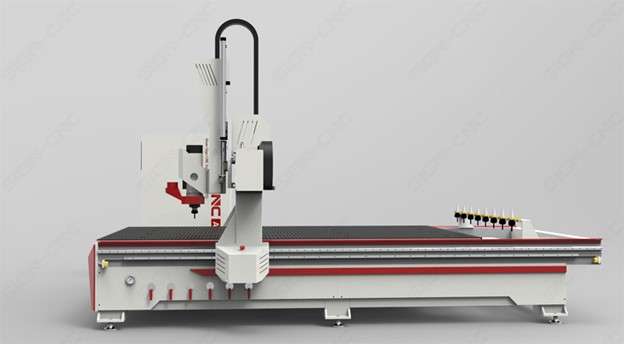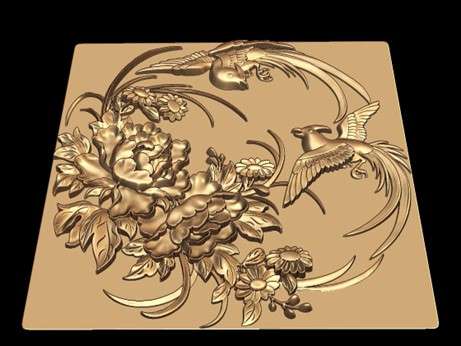CNC routing is one of the prominent machining techniques in the manufacturing industry. It is a subtractive manufacturing method in which the workpiece is manipulated into a desirable shape by removing material. The CNC router performs the routing process comparable to milling but offers less material waste and the capacity to create more complicated designs with high precision.
This article will cover various terminology used in CNC routing, involved stages, advantages, material options, and applications.

CNC routing operation
Understanding of the CNC Routing Process
Before diving into the CNC routing process in depth, let’s get familiar with key terminology.
| Terms | Description |
| CNC | Computer Numerical Control is a method of dictating tools and machine movement using digital instruction through the computer. |
| G-code | G-code is the language used to control the movement of cutting tools in CNC machining. For simple works, it can be input into the CNC machine manually, but CAM software is needed for complex shapes. |
| CAM | Computer Aid Manufacturing (CAM) aids in controlling the production process through the use of a computer. |
| CAD | A computer-generated blueprint of desirable geometry that includes all features, dimensions, and tolerances. |
| Machine controller | An operator interface on a computer allows you to control the numerous machining factors. In addition, it enables the operator to keep track of the job and machining state. |
Stage Involved in CNC Routing
CNC routing is accomplished in three stages: part design, tool setup, and machining.
Stage I: Part design.
The first stage of CNC routing entails designing a part in 2D and 3D, including all features, dimensions, and tolerances. It is usually done with computer software such as AutoCAD, Solid works, Cero, and Fusion360. You can also use open-source design that is freely available on the internet. While creating the 3D model (technical drawing) using software, the designer must consider multiple aspects, such as the capability of the CNC router machine, manufacturing feasibility, complexity, and even the cost of the item.
The outcome of the Designing stage is a 3D file, which can be transferred to the CNC machine later.
Stge2: Tool Path
The next step in CNC routing is to set the tool path after building the 3D model of the part. Depending on the machine, a CNC router can travel along three or four axes. The tool path instructs the router machine about the sequence of machining and positioning of the workpiece on the router bed. Again, CAM software could be the best approach to finding the optimum tool path. After uploading the 3D design, it creates the best possible tool path for CNC routing according to the specification of the part.
Selecting an appropriate routing tool is another factor affecting the machining quality and result. CNC routers use a rotatory cutter to create the exact shape of an uploaded 3D model. The correct tool type and size make the process efficient while limiting material waste and cycle time.
Many factors must be considered while selecting the right type of tool, including part geometry, complexity, material type, surface finish, accuracy, and cycle time. The tool should justify these factors to obtain the quality result from CNC routing.
- Router bits
Router bits are comparable with drill bits, which come in different shapes and sizes with unique shanks and maximum speed.
- Straight bits
- Beading bits
- Rabbeting bits
- Chamfer bits,
- Molding bits

CNC routing bits
These bits deteriorate with continued usage. Therefore the operator must regularly assess the situation.
- Feed rate
The feed rate of the workpiece during routing is critical for smooth machining and avoiding tool overload. If the feed rate is too high, it causes excess heat, poor surface finish, and slipping of the workpiece. Whereas low-feed ate causes more cycle time, clogging of the cutter, and wear on the machining tool. In addition, it can melt the workpiece if you are working with plastics.
If it is flexible, you can find a reasonable feed rate by doing heat and trial methods with the experimental workpiece before starting with the actual workpiece. Also, you can calculate the feed rate by using machining variables in a mathematical expression.
The speed of the CNC router spindle ranges from 7,000rpm to 18,000rpm. Whereas the most common feed rate is 200ipm (CNC Router Feeds and Speeds, 2015)
Stage 3: Machining with CNC router

CNC router machine
Once you fix the tool path with all routing parameters, such as spindle speed, feed rate, and positioning of the workpiece, the actual routing process starts.
There are some parameters you need to fix to begin the manipulation of the workpiece. Set the home position (0, 0, 0) on the top bottom left corner. The Z-axis on the CNC router defines the height of the cutter. You can fix this by jogging the router to just above the workpiece. Remove the chips & dust from the bed as the job progress. Check the control unit of the CNC router machine to ensure everything is going as expected.
Another caution is to ensure the tool path does not interfere with any clamps or vice during the process.
Material Choice for CNC Router
CNC router is compatible with softer materials, including acrylic, polystyrene, low-density polyethylene (LDPE), nylon, plywood, hardwood, fibers, composites, and soft metal & alloys, such as aluminum (Guide To CNC Routing: Lab Manual, 2014).
| Material | Description |
| Woods |
Wood exhibits low hardness and ductility, making it fairly ideal for CNC routing operations. While machining with a CNC router will create small fractured chips that will be thrown from the work area, therefore, the material removal rate needs to be decreased for dense wood. |
| Composites |
Composites are also compatible with the CNC routing process. While machining, it is recommended to use a compression end (Compress the top and bottom surfaces towards the center). Compression resists the possibility of crack openings. |
| Soft plastics |
Soft plastic produces long chips (or curls) with CNC routing operation and is likely to melt easily, so set the low cutting speed and maintain a low ambient temperature. Additionally, cut the ends with fewer flutes or forceful channels. |
| Hard plastics |
It needs to be cut with less with low aggressive channel ends. It is recommended to keep the surrounding temperature cool to prevent the overheating problem. |
| Metal & alloys |
Only soft metals are suitable for CNC routing operations. Therefore, typically, only aluminum projects are done with this process. Long curls are produced during metal routing; high clearance leads to clogging. |
| Ceramics | Low-toughness ceramics such as tile and granite are machinable with CNC routing, which demands high-abrasive tools. |
Why Choose CNC Routing over CNC Milling?
The CNC routing approach facilitates the broad work surface and optimizes the cycle time compared to CNC milling. CNC routers can work with a large sheet, so large parts, and products can be created using routing. The operation and control are relatively less complicated, contributing to high production efficiency. In addition, it eliminates the large workforce, which makes it more cost-effective.
There is a low chance of human error because of the less-complicate operation setup, and it offers a high degree of repeatability. As a result, it is safer for operators and workers than conventional production and other CNC machining techniques.
Applications

Art created with CNC routing.
- Plastic Prototyping
Using CNC routing over milling for plastic prototyping is a big advantage because it offers high precision and less lead time for plastic machining. In addition, complicated and precise plastic prototypes can be routed to different industries, such as robotics and studios.
- Arts & Architecture items
It is the one accurate approach to creating various art of imagination, such as decorative items, jewelry, frames, and several architectural items.
- Automotive & aerospace
Aluminum can be precisely routed to produce engine radiators, bumpers, suspension components, plate sheets, bars, pipes, and numerous other automotive and aerospace parts.
- Furniture
Since CNC routers can work with large sheets, they can be used to create furniture. Moderns and unique furniture are possible with routing operation. Bed, chairs, and dining sets are some examples.
- Trade marks & signs
Trade marks & signs CNC routing is an ideal option for Craving, profiling, and engraving. Therefore, it creates trademarks, advertising signs, and other boards.
Final Thoughts
CNC Routing is a versatile manufacturing approach that offers many advantages over the milling process in different aspects. For example, the high-speed cutter in an advanced CNC router can manipulate all plastics, composites, and some soft metals like aluminum.
Appropriate design & operational considerations are mandatory to create quality & precise parts from CNC routing. For example, the material choice, feed rate, tool path, and type of bit all affect the result of the CNC routing operation. Therefore, it is a complicated process that requires advanced CNC routers and experience professions.
Prolean offers a highly accurate and advanced CNC routing solution for various industries, from decorative items to automotive and aerospace parts. Our Experienced engineers and CNC operators work closely with clients to produce the optimum result. So, please feel free to send your design and get your parts or products to your door within a few days.
FAQ’s
What is CNC routing?
CNC routing is a subtractive manufacturing method that uses fast cutters to convert the workpiece into the desired shape.
What are the stages involved in CNC routing?
There are three major stages in the CNC routing process. , It starts with the Development of a 3D model followed by the identification of tool path and machining using a CNC router.
What are the material options for CNC routing?
All types of plastics, composites, woods, & some ceramics can be used with CNC routers. However, only softer metals can be machined using CNC routers like aluminum.
What are the advantages of CNC routing over milling?
The large sheet can be manipulated using CNC routing for a number of applications. In addition, it reduced the production cycle time & complexity in operation & control.
What are the applications of CNC routing?
CNC routing is the best approach for creating plastic prototypes of different fields and producing signs & trademarks, architectural parts, and various unique furniture.
Bibliography
- (2015). CNC Router Feeds and Speeds. CNC masters.
- (2014). Guide To CNC Routing: Lab Manual. NSAD Materials Lab.




0 Comments